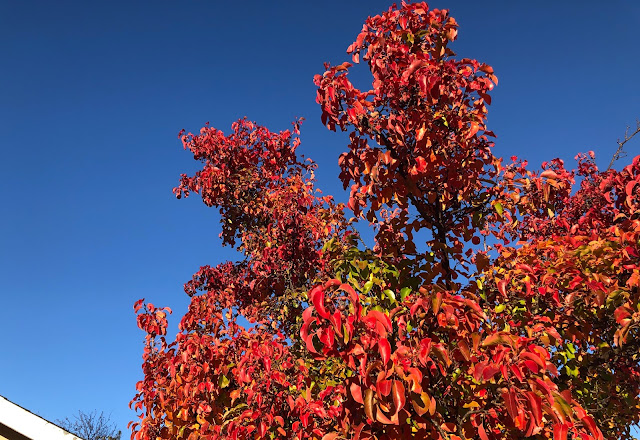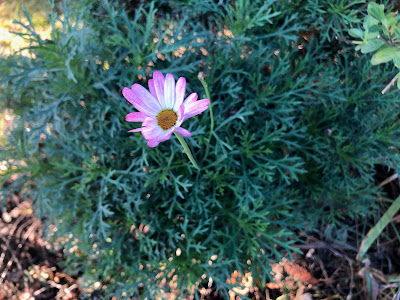
A very quiet Thanksgiving, inside and out

The sky is bright blue this Thanksgiving Day, the temperature mild. The only activity is from the gusts of wind blowing many of the leaves off the trees and into the yards.
When I went out front this morning, I turned back to look at my house. The flowering pear tree ( Pyrus calleryana ), which still has most of its leaves, seemed particularly ablaze with all shades of red and orange, accented by green and yellow closer to the trunk. This show of color, I recalled, is why I planted the tree almost 20 years ago, even though it has since made me a little crazy by sending up suckers all over.

|
|
One pink marguerite blossom, a reminder of summer and
a promise for next year.
|
The gifts of nature can be obvious or subtle, but they are gifts to cherish, especially this year.
I have never been more grateful and happy to be a gardener. In 2020, gardening has been my lifeline, something to hang onto while the outside world was turning upside down. Seeds planted still sprout and produce food, for humans or for the wildlife. Flowers bloom, even when the air is too smoky for humans to breathe. Trees turn color unprompted.
Last Thanksgiving, I put together a list of things that gardeners can be thankful for, which I will recap here, since they are still relevant, of course. There's just a small update.
I am thankful for:
-- Pollinators who do their thing in the garden on their own time, and do even more with a little encouragement (and plants they love). From almonds to zucchini, the area's crops and our home gardens depend on the bees, birds, butterflies and other insects.
-- The trees that shade our homes and give us mulch in the fall, as well as provide food -- even if just for wildlife (oh, those squirrels!) -- and homes for birds.
-- The magical soil below us, full of nutrients and microbes and earthworms and so many things we're not aware of as we walk over it.
-- Our gorgeous Mediterranean climate, which even as it's changing lets us work outside nearly year-round and grow so many things so well that we're the envy of the rest of the country's gardeners.
--The wonder of tiny seeds that turn into 2-pound tomatoes with just the right amount of care.
-- Finally, the generosity of fellow gardeners, who give freely of seeds, plants, produce, tools and advice. If someone says, "Oh, you're a gardener, too!" you have instant rapport. And this year, my community widened with all my new master gardener colleagues, including my Zoom-assisted Class of 2020. (Congrats to us! Hope to see you all in person again someday.)
Happy Thanksgiving, everyone. Stay healthy and keep gardening!
Comments
0 comments have been posted.Sacramento Digs Gardening to your inbox.
Sites We Like
Garden Checklist for week of July 21
Your garden needs you!
* Keep your vegetable garden watered, mulched and weeded. Water before 8 a.m. to reduce the chance of fungal infection and to conserve moisture.
* Feed vegetable plants bone meal, rock phosphate or other fertilizers high in phosphate to stimulate more blooms and fruiting. (But wait until daily high temperatures drop out of the 100s.)
* Don’t let tomatoes wilt or dry out completely. Give tomatoes a deep watering two to three times a week.
* Harvest vegetables promptly to encourage plants to produce more. Squash especially tends to grow rapidly in hot weather. Keep an eye on zucchini.
* Pinch back chrysanthemums for bushy plants and more flowers in September.
* Remove spent flowers from roses, daylilies and other bloomers as they finish flowering.
* Pinch off blooms from basil so the plant will grow more leaves.
* Cut back lavender after flowering to promote a second bloom.
* It's not too late to add a splash of color. Plant petunias, snapdragons, zinnias and marigolds.
* From seed, plant corn, pumpkins, radishes, winter squash and sunflowers.